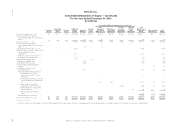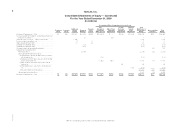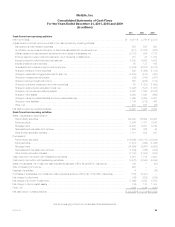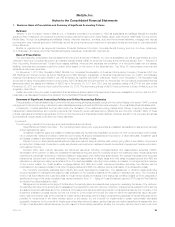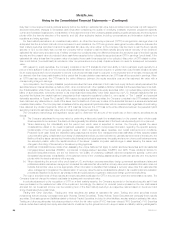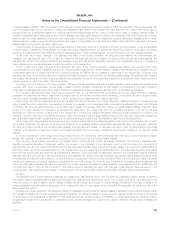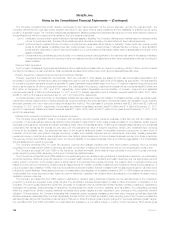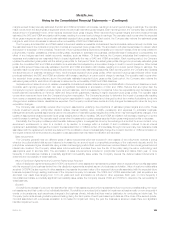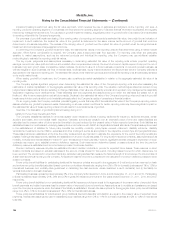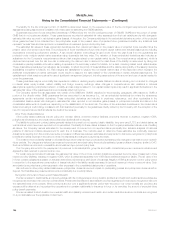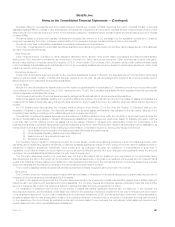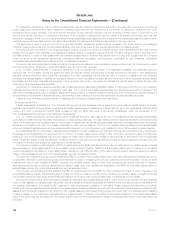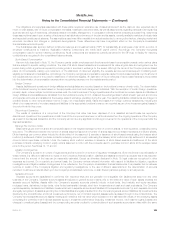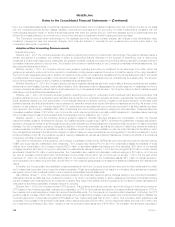MetLife 2011 Annual Report Download - page 105
Download and view the complete annual report
Please find page 105 of the 2011 MetLife annual report below. You can navigate through the pages in the report by either clicking on the pages listed below, or by using the keyword search tool below to find specific information within the annual report.MetLife, Inc.
Notes to the Consolidated Financial Statements — (Continued)
recognized asset or liability (“cash flow hedge”); or (iii) a hedge of a net investment in a foreign operation. In this documentation, the Company sets forth
how the hedging instrument is expected to hedge the designated risks related to the hedged item and sets forth the method that will be used to
retrospectively and prospectively assess the hedging instrument’s effectiveness and the method which will be used to measure ineffectiveness. A
derivative designated as a hedging instrument must be assessed as being highly effective in offsetting the designated risk of the hedged item. Hedge
effectiveness is formally assessed at inception and periodically throughout the life of the designated hedging relationship. Assessments of hedge
effectiveness and measurements of ineffectiveness are also subject to interpretation and estimation and different interpretations or estimates may have a
material effect on the amount reported in net income.
The accounting for derivatives is complex and interpretations of the primary accounting guidance continue to evolve in practice. Judgment is applied
in determining the availability and application of hedge accounting designations and the appropriate accounting treatment under such accounting
guidance. If it was determined that hedge accounting designations were not appropriately applied, reported net income could be materially affected.
Under a fair value hedge, changes in the estimated fair value of the hedging derivative, including amounts measured as ineffectiveness, and
changes in the estimated fair value of the hedged item related to the designated risk being hedged, are reported within net derivative gains (losses). The
estimated fair values of the hedging derivatives are exclusive of any accruals that are separately reported in the consolidated statement of operations
within interest income or interest expense to match the location of the hedged item.
Under a cash flow hedge, changes in the estimated fair value of the hedging derivative measured as effective are reported within other
comprehensive income (loss), a separate component of stockholders’ equity and the deferred gains or losses on the derivative are reclassified into the
consolidated statement of operations when the Company’s earnings are affected by the variability in cash flows of the hedged item. Changes in the
estimated fair value of the hedging instrument measured as ineffectiveness are reported within net derivative gains (losses). The estimated fair values of
the hedging derivatives are exclusive of any accruals that are separately reported in the consolidated statement of operations within interest income or
interest expense to match the location of the hedged item.
In a hedge of a net investment in a foreign operation, changes in the estimated fair value of the hedging derivative that are measured as effective are
reported within other comprehensive income (loss) consistent with the translation adjustment for the hedged net investment in the foreign operation.
Changes in the estimated fair value of the hedging instrument measured as ineffectiveness are reported within net derivative gains (losses).
The Company discontinues hedge accounting prospectively when: (i) it is determined that the derivative is no longer highly effective in offsetting
changes in the estimated fair value or cash flows of a hedged item; (ii) the derivative expires, is sold, terminated, or exercised; (iii) it is no longer probable
that the hedged forecasted transaction will occur; or (iv) the derivative is de-designated as a hedging instrument.
When hedge accounting is discontinued because it is determined that the derivative is not highly effective in offsetting changes in the estimated fair
value or cash flows of a hedged item, the derivative continues to be carried in the consolidated balance sheets at its estimated fair value, with changes
in estimated fair value recognized currently in net derivative gains (losses). The carrying value of the hedged recognized asset or liability under a fair value
hedge is no longer adjusted for changes in its estimated fair value due to the hedged risk, and the cumulative adjustment to its carrying value is
amortized into income over the remaining life of the hedged item. Provided the hedged forecasted transaction is still probable of occurrence, the
changes in estimated fair value of derivatives recorded in other comprehensive income (loss) related to discontinued cash flow hedges are released into
the consolidated statements of operations when the Company’s earnings are affected by the variability in cash flows of the hedged item.
When hedge accounting is discontinued because it is no longer probable that the forecasted transactions will occur on the anticipated date or within
two months of that date, the derivative continues to be carried in the consolidated balance sheets at its estimated fair value, with changes in estimated
fair value recognized currently in net derivative gains (losses). Deferred gains and losses of a derivative recorded in other comprehensive income (loss)
pursuant to the discontinued cash flow hedge of a forecasted transaction that is no longer probable are recognized immediately in net derivative gains
(losses).
In all other situations in which hedge accounting is discontinued, the derivative is carried at its estimated fair value in the consolidated balance
sheets, with changes in its estimated fair value recognized in the current period as net derivative gains (losses).
The Company issues certain products and purchases certain investments that contain embedded derivatives. The Company assesses each
identified embedded derivative to determine whether it is required to be bifurcated. If the instrument would not be accounted for in its entirety at
estimated fair value and it is determined that the terms of the embedded derivative are not clearly and closely related to the economic characteristicsof
the host contract, and that a separate instrument with the same terms would qualify as a derivative instrument, the embedded derivative is bifurcated
from the host contract and accounted for as a freestanding derivative. Such embedded derivatives are carried in the consolidated balance sheets at
estimated fair value with the host contract and changes in their estimated fair value are generally reported in net derivative gains (losses) except for those
in policyholder benefits and claims related to ceded reinsurance of guaranteed minimum income benefits (“GMIB”). If the Company is unable to properly
identify and measure an embedded derivative for separation from its host contract, the entire contract is carried on the balance sheet at estimated fair
value, with changes in estimated fair value recognized in the current period in net investment gains (losses) or net investment income. Additionally, the
Company may elect to carry an entire contract on the balance sheet at estimated fair value, with changes in estimated fair value recognized in the
current period in net investment gains (losses) or net investment income if that contract contains an embedded derivative that requires bifurcation.
Fair Value
As described below, certain assets and liabilities are measured at estimated fair value in the Company’s consolidated balance sheets. In addition,
the notes to these consolidated financial statements include further disclosures of estimated fair values. The Company defines fair value as the price that
would be received to sell an asset or paid to transfer a liability (an exit price) in the principal or most advantageous market for the asset or liability in an
orderly transaction between market participants on the measurement date. In most cases, the exit price and the transaction (or entry) price will be the
same at initial recognition.
Subsequent to initial recognition, fair values are based on unadjusted quoted prices for identical assets or liabilities in active markets that are readily
and regularly obtainable. When such quoted prices are not available, fair values are based on quoted prices in markets that are not active, quoted prices
for similar but not identical assets or liabilities, or other observable inputs. If these inputs are not available, or observable inputs are not determinative,
unobservable inputs and/or adjustments to observable inputs requiring management judgment are used to determine the fair value of assets and
liabilities.
MetLife, Inc. 101


